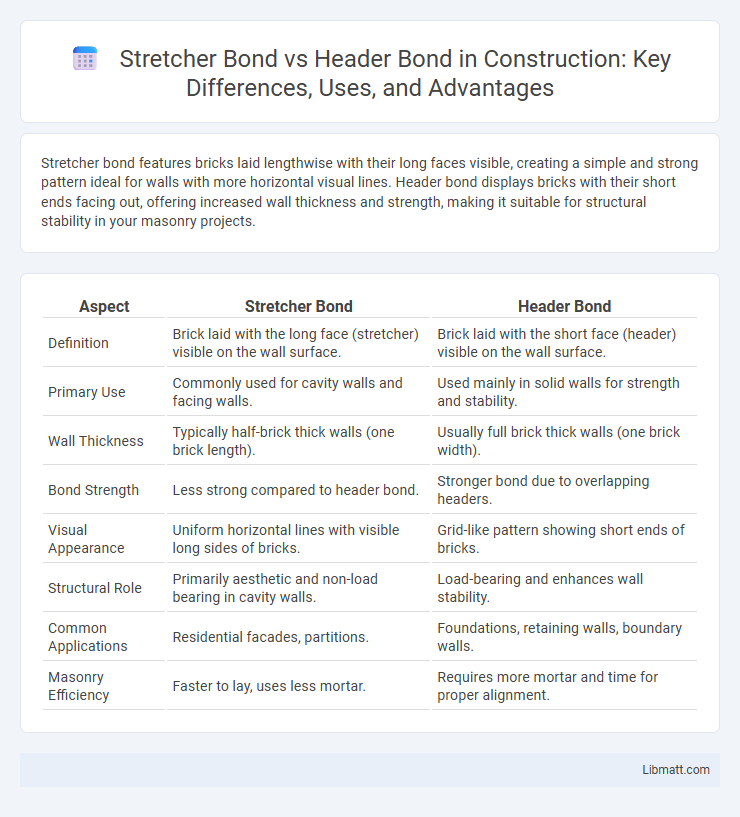Stretcher bond features bricks laid lengthwise with their long faces visible, creating a simple and strong pattern ideal for walls with more horizontal visual lines. Header bond displays bricks with their short ends facing out, offering increased wall thickness and strength, making it suitable for structural stability in your masonry projects.
Table of Comparison
| Aspect | Stretcher Bond | Header Bond |
|---|---|---|
| Definition | Brick laid with the long face (stretcher) visible on the wall surface. | Brick laid with the short face (header) visible on the wall surface. |
| Primary Use | Commonly used for cavity walls and facing walls. | Used mainly in solid walls for strength and stability. |
| Wall Thickness | Typically half-brick thick walls (one brick length). | Usually full brick thick walls (one brick width). |
| Bond Strength | Less strong compared to header bond. | Stronger bond due to overlapping headers. |
| Visual Appearance | Uniform horizontal lines with visible long sides of bricks. | Grid-like pattern showing short ends of bricks. |
| Structural Role | Primarily aesthetic and non-load bearing in cavity walls. | Load-bearing and enhances wall stability. |
| Common Applications | Residential facades, partitions. | Foundations, retaining walls, boundary walls. |
| Masonry Efficiency | Faster to lay, uses less mortar. | Requires more mortar and time for proper alignment. |
Introduction to Brick Bond Patterns
Stretcher bond and header bond are fundamental brick bond patterns used in masonry construction to enhance structural integrity and aesthetic appeal. Stretcher bond features bricks laid lengthwise with only their long narrow faces visible, ideal for constructing walls where strength and speed are prioritized. Header bond, characterized by bricks laid with their short ends facing outward, provides superior load distribution and decorative texture, making it suitable for load-bearing walls and architectural accents.
What is a Stretcher Bond?
Stretcher bond is a bricklaying pattern where bricks are laid with their long, narrow side (stretcher) facing outward, creating a uniform and linear appearance. This bond is commonly used for walls that are one brick thick, providing structural stability and an aesthetic, orderly look. It offers efficient use of bricks and is often preferred in modern construction for its simplicity and strength.
What is a Header Bond?
A header bond is a brickwork pattern where bricks are laid with their shorter ends, or headers, facing the wall's surface, creating a strong interlocking structure. This bond enhances wall strength and stability by tying the exterior brick facing to the backing masonry. Understanding the difference between stretcher and header bonds helps you choose the right pattern for durability and aesthetic appeal in your construction project.
Structural Differences Between Stretcher and Header Bonds
Stretcher bonds feature bricks laid lengthwise with their long sides facing outward, creating a uniform, linear pattern ideal for walls with moderate load-bearing needs. Header bonds, by contrast, position bricks with their short ends facing outward, interlocking layers more securely and providing greater structural stability in thicker walls. Your choice between these bonds influences wall strength and aesthetic, with stretcher bonds suited for facade finish and header bonds enhancing overall wall integrity.
Aesthetic and Visual Appeal Comparison
Stretcher bond creates a clean, uniform appearance with horizontally aligned bricks that emphasize length and linearity, making walls appear longer and more streamlined. Header bond offers a more textured, patterned look due to the alternating brick ends facing outward, adding visual interest and a sense of depth to your surfaces. Your choice between these bonds will impact the overall architectural style, with stretcher bond favoring simplicity and header bond enhancing decorative complexity.
Strength and Stability: Which Bond Performs Better?
Stretcher bond provides moderate strength and stability, making it suitable for non-load-bearing walls due to its alignment of bricks with their longest face visible. Header bond offers superior strength and stability by laying bricks with the short face visible, effectively tying the wall's inner and outer layers together for enhanced load distribution. In terms of structural performance, header bond outperforms stretcher bond by creating a more robust and cohesive masonry wall.
Common Applications of Stretcher Bonds
Stretcher bonds are commonly used in the construction of walls where strength and uniform appearance are essential, such as in residential building facades and garden walls. This bond pattern provides excellent stability due to the overlapping joints, making it ideal for load-bearing walls and long stretches of brickwork. Your project will benefit from stretcher bonds if you require a simple, cost-effective design with efficient use of bricks.
Common Applications of Header Bonds
Header bonds are commonly used in walls requiring enhanced strength and stability, such as boundary walls, retaining walls, and basement constructions. This bond pattern ties the external layers of brickwork to the internal structure, improving load distribution and structural integrity. Your building project will benefit from the header bond's ability to create solid, interlocked walls ideal for heavy-duty applications.
Cost and Construction Efficiency
Stretcher bond offers cost-effective construction with fewer bricks and faster laying times, making it ideal for non-load bearing walls and budget projects. Header bond involves more bricks and labor due to the alternating brick orientation, resulting in higher costs but improved wall strength. Your choice between stretcher and header bonds impacts both material expenses and construction efficiency depending on structural requirements.
Choosing the Right Bond: Stretcher vs Header
Selecting the appropriate brick bond depends on structural requirements and visual appeal; stretcher bond offers a uniform, linear pattern ideal for non-load-bearing walls and veneers, maximizing speed and efficiency in construction. Header bond provides greater strength and stability by interlocking bricks across the wall's thickness, making it suitable for load-bearing walls and enhancing wall thickness. Understanding the functional differences and aesthetic outcomes of stretcher and header bonds ensures optimal performance and design in masonry projects.
Stretcher bond vs header bond Infographic

 libmatt.com
libmatt.com